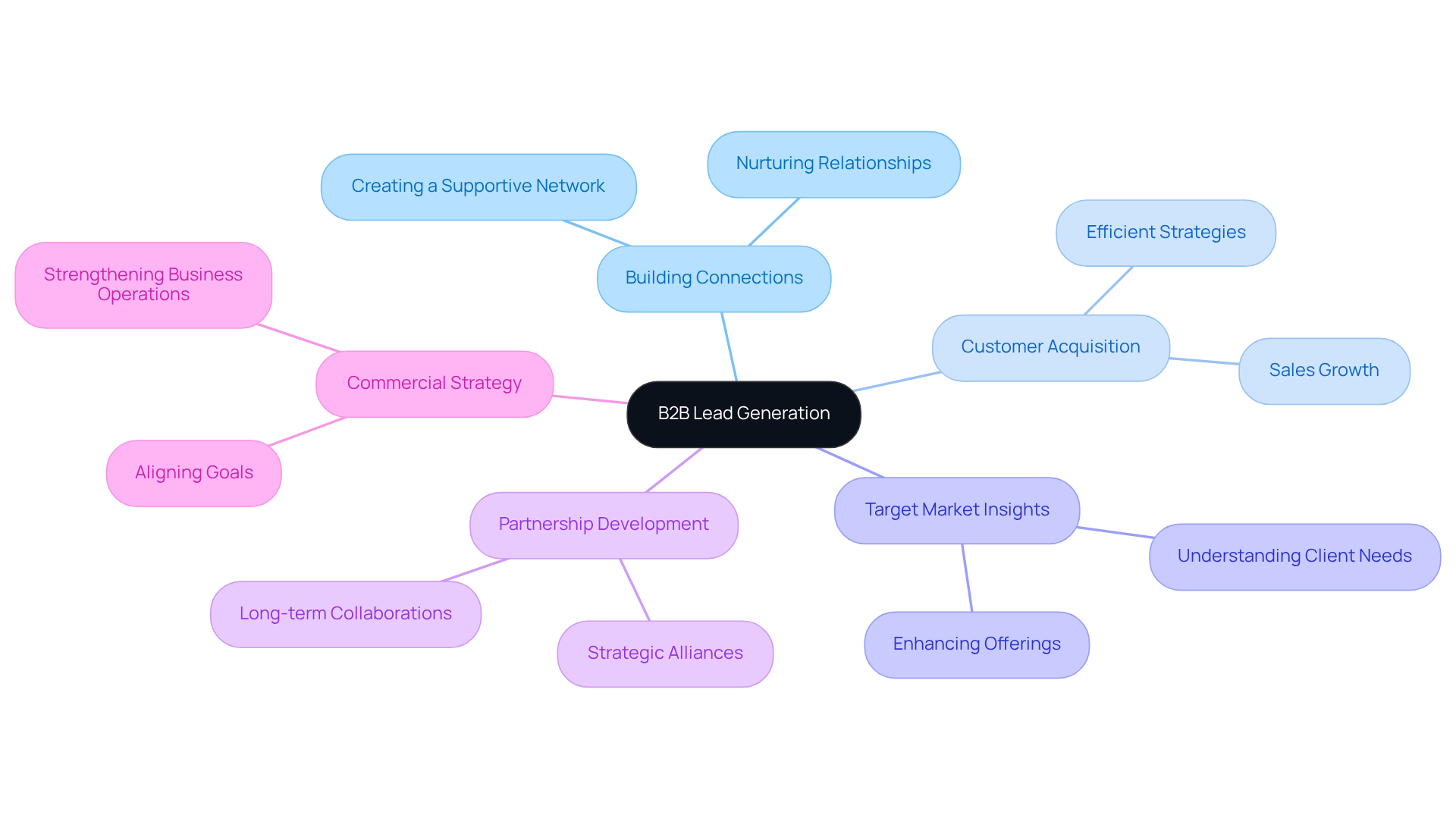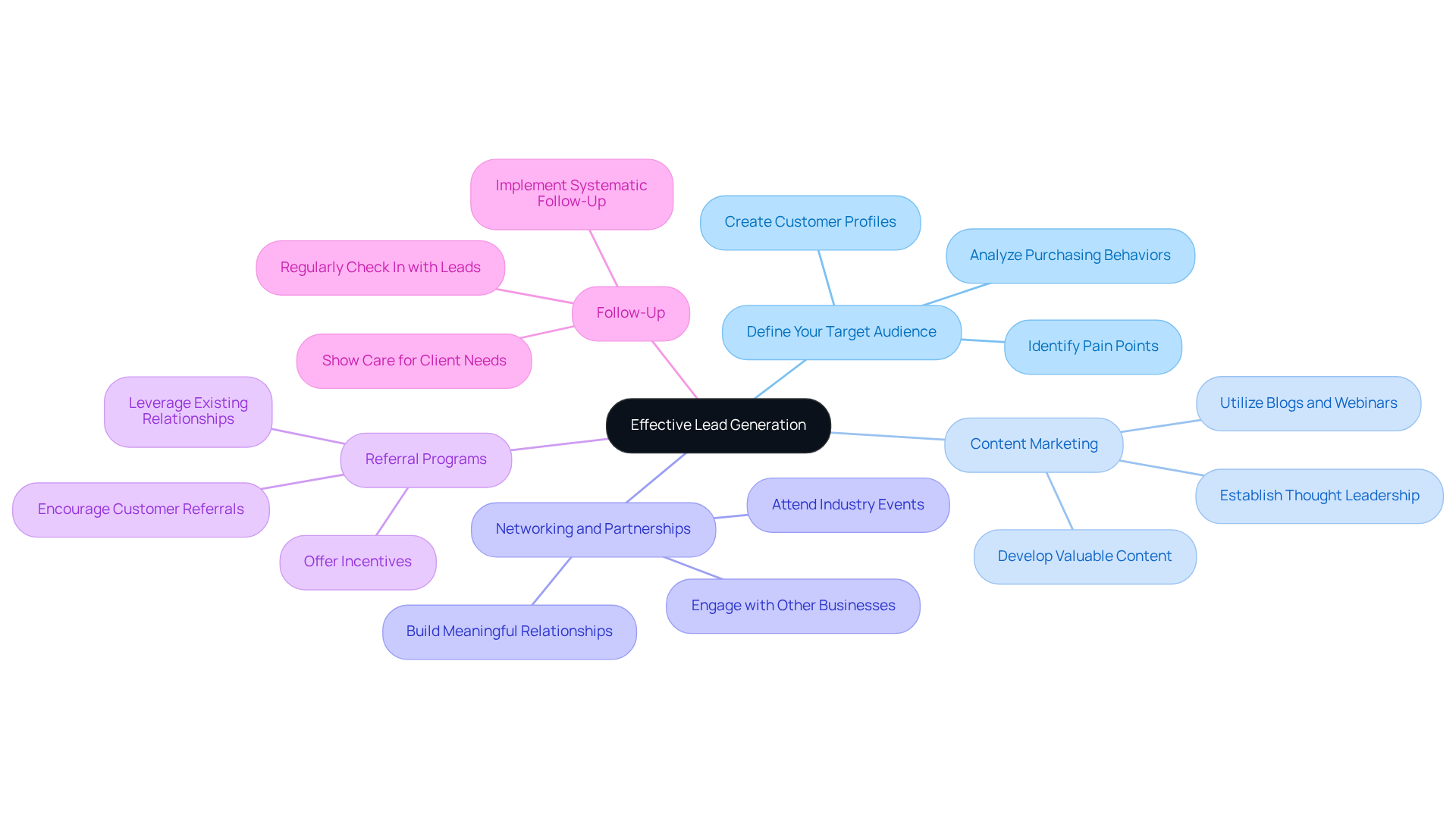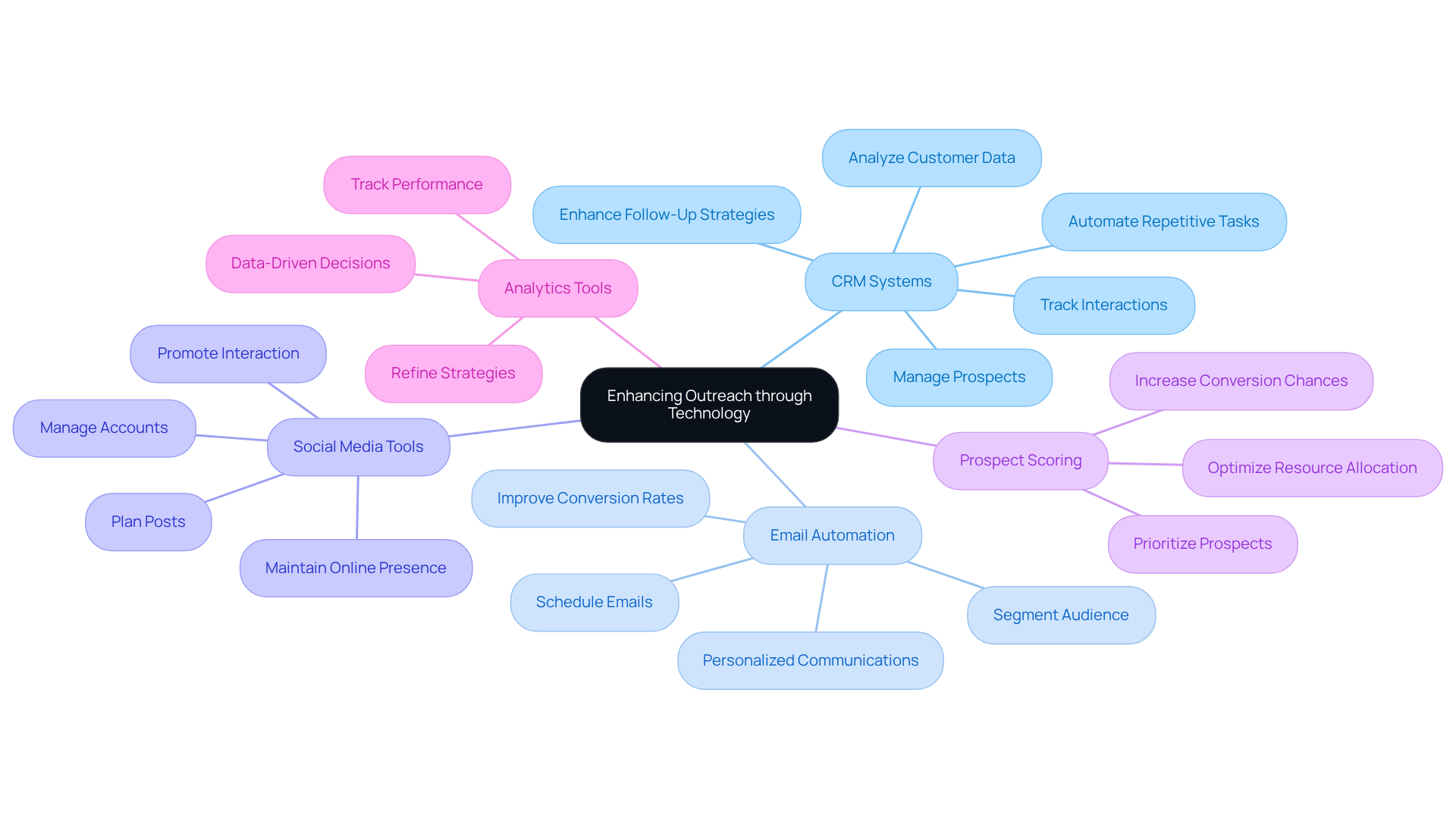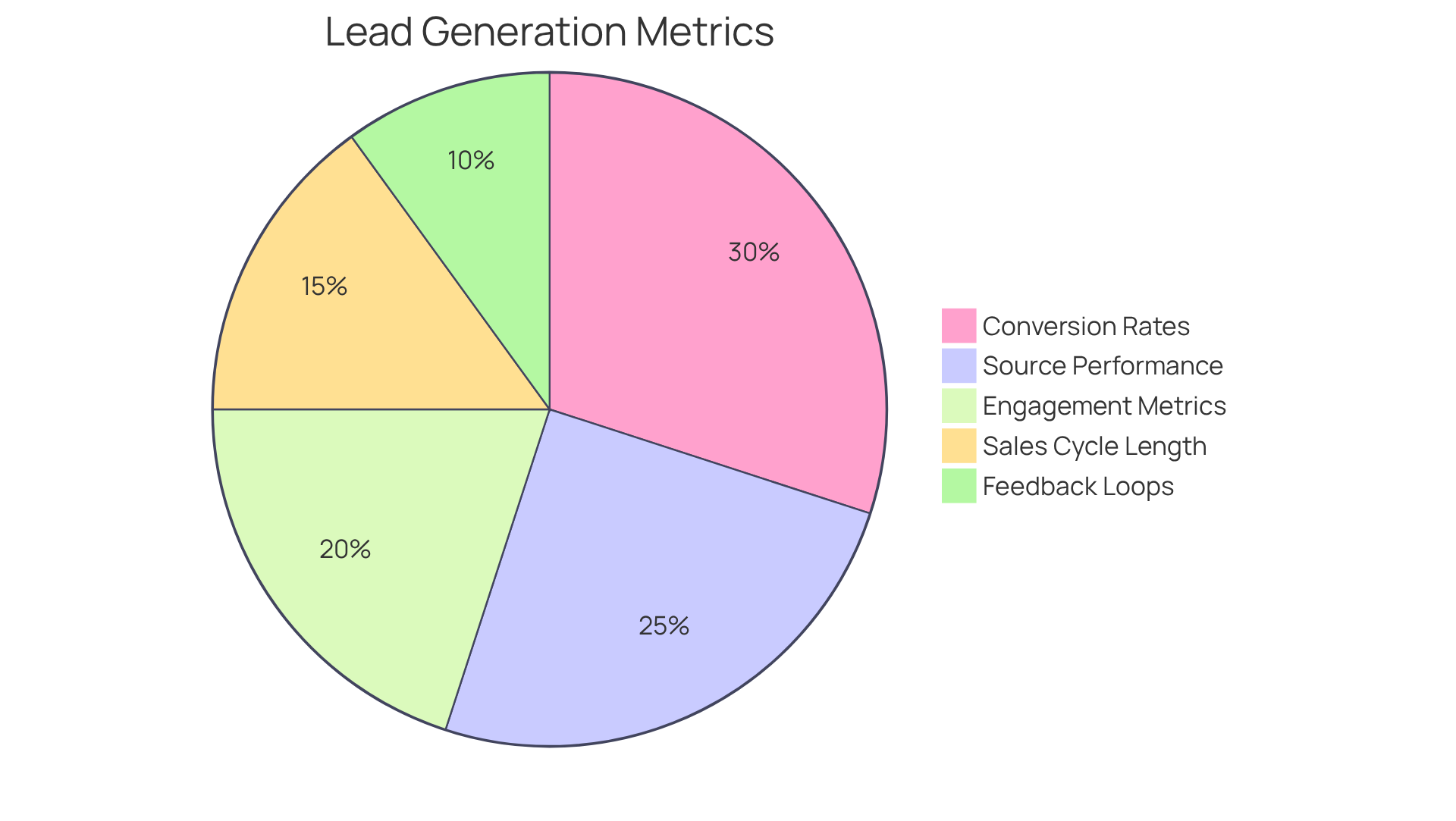Overview
In today's competitive landscape, mastering business-to-business (B2B) lead generation is crucial for small businesses. We understand your challenges, and effective lead generation is not just about increasing sales; it’s about building long-term partnerships that can sustain your business. By defining your target audience, utilizing content marketing, and leveraging technology like CRM systems, you can enhance your outreach and improve conversion rates.
Imagine having a clear understanding of who your ideal customers are. This clarity allows you to tailor your marketing efforts, making them more impactful. Content marketing can serve as a powerful tool to engage potential clients, providing them with valuable insights while showcasing your expertise. Additionally, technology can streamline your processes, making it easier to nurture leads and convert them into loyal customers.
Ultimately, these strategies collectively foster business growth. As you implement these proven techniques, you’ll not only drive sales but also establish meaningful connections with your clients. Together, we can achieve success by focusing on what truly matters: understanding your audience and meeting their needs. Take the first step today towards mastering B2B lead generation, and watch your business flourish.
Introduction
In the fast-paced realm of small business, we understand that the ability to effectively generate leads can be the difference between stagnation and growth. Business to business (B2B) lead generation is not merely about acquiring clients; it’s a strategic approach to cultivating meaningful connections that can transform into long-lasting partnerships. As competition intensifies, grasping the nuances of B2B lead generation becomes essential for small enterprises aiming to thrive.
How can we harness these strategies to not only attract leads but also foster a supportive network that propels us forward in an ever-evolving marketplace? Together, we can explore the pathways to success.
Understand the Importance of B2B Lead Generation
Business to business lead generation involves more than just finding potential corporate clients; it’s about building connections that matter. For small enterprises, business to business lead generation is crucial, as it not only drives sales but also facilitates the creation of long-term partnerships. When you focus on efficient customer acquisition, you gain deeper insights into your target market, allowing you to enhance your offerings and ultimately increase your revenue. In a competitive landscape, business to business lead generation is vital for maintaining a steady stream of prospects to sustain operations and foster growth.
By prioritizing business to business lead generation, you can cultivate relationships that naturally evolve into sales. This approach not only strengthens your overall commercial strategy but also aligns with your goals as an entrepreneur. We understand your challenges, and by nurturing these connections, you can create a supportive network that propels your business forward. Together, let’s explore how you can turn potential clients into lasting partnerships.

Implement Proven Strategies for Effective Lead Generation
To effectively generate leads, small businesses can embrace several nurturing strategies that truly resonate with their unique challenges:
-
Define Your Target Audience: Understanding who your ideal clients are is the first step. By creating detailed customer profiles that include demographics, pain points, and purchasing behaviors, you can improve your business to business lead generation by tailoring your approach to meet their needs.
-
Content Marketing: Develop valuable content that addresses the needs and interests of your target audience. This could encompass blog articles, whitepapers, or webinars that not only inform but also establish your organization as a trusted thought leader in your field.
-
Networking and Partnerships: Attend industry events and engage with other businesses to build meaningful relationships that can lead to referrals and fruitful collaborations. Remember, every connection could be a potential opportunity.
-
Referral Programs: Encourage satisfied customers to refer new clients by offering incentives. This approach to business to business lead generation leverages existing relationships, making it easier to expand your reach while rewarding loyalty.
-
Follow-Up: Implement a systematic follow-up process for leads. Many sales are lost due to a lack of timely communication. Regularly check in with potential clients to keep your business top-of-mind, showing them that you care about their needs and are ready to assist.
By focusing on these strategies, you can create a supportive environment that not only attracts leads but also fosters lasting relationships.

Leverage Technology and Automation for Enhanced Outreach
Integrating technology into your business to business lead generation strategy can significantly enhance your outreach efforts, and we understand that navigating this landscape can feel overwhelming. Here are some effective methods to consider that can truly make a difference:
-
CRM Systems: Implementing Customer Relationship Management (CRM) software is essential for managing prospects, tracking interactions, and analyzing customer data. This technology not only facilitates tailored outreach but also enhances follow-up strategies, ensuring that no opportunity is overlooked. Many businesses utilizing CRM systems have reported increased sales productivity and efficiency, as these tools automate repetitive tasks and centralize customer information, allowing you to focus on what matters most.
-
Email Automation: Leveraging email marketing tools to automate outreach campaigns can dramatically improve lead generation success rates. By scheduling emails to be sent at optimal times and segmenting your audience for targeted messaging, you can significantly enhance business to business lead generation. Success stories highlight that businesses utilizing business to business lead generation through email automation have experienced substantial growth in conversion rates, as personalized communications resonate more deeply with prospective customers.
-
Social Media Tools: Connecting with potential clients through social media platforms is essential in today’s digital landscape. Tools like Hootsuite or Buffer empower you to manage various accounts and plan posts, helping maintain a steady online presence that draws interest and promotes interaction. Remember, every interaction can lead to a valuable connection.
-
Prospect Scoring: Implementing prospect scoring systems allows you to prioritize prospects based on their engagement and likelihood to convert. This strategic approach to business to business lead generation enables your sales team to concentrate on the most promising prospects, ultimately increasing conversion chances and optimizing resource allocation. It’s about working smarter, not harder.
-
Analytics Tools: Utilizing analytics to track the performance of your prospect generation efforts is crucial. Tools like Google Analytics provide insights into website traffic and user behavior, allowing you to refine your strategies based on data-driven decisions. By understanding which channels and messages yield the best results, you can continuously improve your outreach efforts, ensuring that your message reaches those who need it most.
Together, by embracing these technologies, we can navigate the complexities of prospect generation and achieve success in your outreach efforts.

Measure and Analyze Lead Generation Success for Continuous Improvement
To ensure ongoing enhancement in your prospect generation efforts, it's essential to measure and analyze your success with compassion and understanding. Here are some key metrics to track that can truly make a difference:
-
Conversion Rates: Keep an eye on the percentage of prospects that convert into customers. This insight helps you assess the effectiveness of your outreach strategies and can guide you toward more meaningful connections.
-
Source Performance: Take a moment to analyze which channels are generating the most prospects. This understanding allows you to allocate your resources more effectively, ensuring your efforts are directed where they matter most.
-
Engagement Metrics: Monitor how prospects interact with your content and communications. High engagement rates often correlate with higher conversion potential, reflecting the genuine interest of your audience.
-
Sales Cycle Length: Measure the time it takes for a lead to convert into a transaction. Understanding this can assist in optimizing your selling procedure, making the journey smoother for both you and your prospects.
-
Feedback Loops: Regularly solicit feedback from your sales team and clients to identify areas for improvement. This practice can provide qualitative insights that numbers alone may not reveal, helping you to grow and adapt.
By consistently measuring these metrics, small businesses like yours can refine their lead generation strategies. Together, we can ensure that your efforts remain effective and aligned with your growth objectives, fostering a supportive environment for success.

Conclusion
Mastering business-to-business (B2B) lead generation is essential for small businesses striving to thrive in today’s competitive market. It’s not just about identifying potential clients; it’s about fostering meaningful relationships that can evolve into long-term partnerships. By prioritizing effective lead generation strategies, small enterprises can enhance their customer acquisition efforts, gain valuable insights into their target market, and ultimately drive growth.
This article outlines several proven strategies to improve lead generation. These include:
- Defining target audiences
- Leveraging content marketing
- Utilizing networking opportunities
It’s important to recognize the role of technology, such as CRM systems and email automation, in streamlining outreach and enhancing engagement. Moreover, measuring success through key metrics like conversion rates and engagement levels is crucial for continuous improvement and refining strategies.
In conclusion, embracing these insights and tactics can significantly impact the growth of small businesses. By taking actionable steps towards effective B2B lead generation, entrepreneurs can create a sustainable pipeline of prospects and build a supportive network that propels their business forward. The time to invest in these strategies is now; the future success of small businesses hinges on their ability to connect, engage, and nurture relationships in the ever-evolving landscape of B2B commerce. Together, we can navigate these challenges and achieve lasting success.
Frequently Asked Questions
What is B2B lead generation?
B2B lead generation involves identifying and building connections with potential corporate clients to drive sales and create long-term partnerships.
Why is B2B lead generation important for small enterprises?
It is crucial for small enterprises as it not only drives sales but also helps in creating long-term partnerships, gaining insights into the target market, and ultimately increasing revenue.
How does B2B lead generation contribute to a business's growth?
By maintaining a steady stream of prospects, B2B lead generation supports business operations and fosters growth in a competitive landscape.
What is the relationship between B2B lead generation and customer acquisition?
Focusing on efficient customer acquisition through B2B lead generation allows businesses to gain deeper insights into their target market and enhance their offerings.
How can nurturing connections through B2B lead generation benefit a business?
Nurturing connections can lead to the development of relationships that naturally evolve into sales, strengthening the overall commercial strategy and aligning with entrepreneurial goals.




